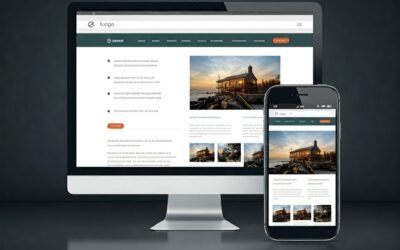Greatest Site Builder 2023: Divi v Elementor
Introduction
Which is the greatest site builder? Welcome to our comprehensive comparison of two of the most popular WordPress page builders, Divi and Elementor.
If you’re struggling to choose between these two powerful tools, you’ve come to the right place. In this article, we will dive deep into the key differences, features, and benefits of both Divi and Elementor to help you make an informed decision.
Whether you’re a beginner or an experienced developer, we’ll provide you with all the information you need to select the best page builder for your website.
Key Differences between Divi and Elementor
Before we delve into the detailed comparison, let’s highlight some of the key differences between Divi and Elementor:
Design Approach
Divi follows a hierarchical approach where you can see the body of your website in order, while Elementor gives you complete freedom to design with a cleaner interface.
canHowever, building your site in the front end with Divi is possible. When editing a page or post using Divi, you have the ability to customise everything you see, including the template! That means you can edit headers and footers in context with one visual editing experience. No need to jump back and forth to Theme Builder.
A/B Testing
Divi offers an A/B testing module, allowing you to test different variations of your website, while Elementor does not have this feature.
However, it is possible to carry out A/B testing in Elementor sites by using
A/B testing WordPress and Elementor content using the free Google Optimize service. Also, there is a native WordPress plugin option for Elementor users that lets you set up split tests from inside the Elementor editor.
Hosting Solution
With the Elementor cloud website plan, you don’t have to search for a hosting provider as it includes Google Cloud hosting. On the other hand, Divi requires you to rely on a third-party hosting provider for hosting services.
Ease of Use
Both Divi and Elementor offer intuitive drag-and-drop editors that make website design accessible to users without technical knowledge. However, there are some differences in their user interfaces.
Divi provides both front-end and back-end visual editing options. You can choose to start with a blank page, a premade template, or clone an existing page. Divi’s interface includes floating buttons instead of a fixed sidebar like Elementor.
Elementor, on the other hand, presents a fixed sidebar on the left side and a live preview of changes on the right side. You can hide the sidebar for a full-page preview. Adding new elements to the page is as simple as dragging and dropping them from the sidebar or using the text editor.
In terms of ease of use, Elementor has an advantage due to its fixed sidebar and smooth drag-and-drop functionality.
However, in my personal experience, Elementor still has room for improvement in this area. For example, when using a plugin like Internal Link Juicer to build internal links on your site automatically, I have to use the basic WordPress editor to access the right-hand sidebar where I can then add keywords I want to use to create internal links. It would be nice if Elementor would integrate this and similar plugin options into its left sidebar to improve workflow.
Modules & Sections
Both Divi and Elementor offer a range of modules and sections to help you design your web pages. Divi has three building blocks: rows, sections, and modules.
Sections act as containers, while rows and modules provide design elements. Divi also includes a split testing feature to compare different elements on your web page.
Elementor uses sections, columns, and widgets. Sections contain columns and widgets, allowing you to structure your page vertically.
Unlike Divi, Elementor allows you to resize columns using drag-and-drop. It offers over 100 widgets in Elementor Pro, and you can further expand the selection with third-party add-ons.
Both Divi and Elementor provide similar module and section options, making it a tie between the two in this category.
Important news:
Elementor has adopted Flexbox Containers (Status: Release Candidate) and Grid Containers (Status: Alpha). You need to enable the Flexbox Containers option to be able to activate the Grid Containers option.
Flexbox Containers allow you to create advanced layouts and responsive designs with the new Flexbox Container element.
This replaces the current section/column structure, but you’ll still keep your existing Sections, Inner Sections and Columns and be able to edit them. Learn more
Grid Containers enable you to create pixel-perfect layouts by placing elements in a customizable grid. Activate to add the CSS Grid option to container elements. Learn more
SEO Friendliness
Considering the impact on SEO is crucial when selecting a page builder. Divi relies heavily on shortcodes, which can cause issues if you deactivate the page builder, leaving broken shortcodes on your website.
In my personal experience, this was the biggest bugbear with Divi and one reason I switched to mainly using Elementor Pro.
If you intend to stay with Divi then this isn’t so much a problem, but I did find that if I switched from the Divi Theme to another one, whilst still using the Divi Builder, I also had issues with random code appearing in the frontend.
In contrast, Elementor focuses on clean code and restricts the use of shortcodes, improving your website’s loading time and preventing shortcode clutter.
Even if you deactivate Elementor, your website remains intact with clean code.
From an SEO perspective, Elementor is the better choice due to its cleaner code and optimized structure.
Styling Options
Both Divi and Elementor offer comprehensive styling options to customise your web pages.
Divi:
Divi provides three tabs: content, design, and advanced.
Content: allows you to change such basic settings as the text.
Design: this allows you to vary the colours, use animation, add shadows etc to your layout.
Advanced: Here you can add CSS to tweak the styling etc as well as change how things look on different devices.
Elementor:
Like Divi, Elementor also offers three tabs: content, style, and advanced. These tabs allow you to make various modifications to your website.
Style and content: In the style and content tabs, you can easily change colours, typography, and alignment.
Advanced: The advanced tab provides options to adjust margins and padding, apply entrance animations, and even add custom CSS. With Elementor Pro, you have the added benefit of directly adding custom CSS to any element you desire.
Kit Library: Elementor offers various ready-made themes etc, available through it’s kit library. This makes it relatively easy to get a website up and running quickly.
itsYou can then tweak it with your itscontent and images. You can also change various aspects of the styling such as colour palette and fonts. Divi offers similar features through it’s library.

Divi Theme Options
Divi Theme Options are found in the WordPress Dashboard left menu. Here you can customise how your theme is set up, including turning Google Fonts on or off. There are so many options that they have broken them up into various tabs. If you get confused by all the options, Elegant Themes have extensive tutorials and help files. In addition, they provide excellent support and have a huge community that also contributes answers to questions. My own experience is that they provide one of the best, if not the best, help and support resources.
Elementor Theme Options
Elementor has some options in the WordPress Dashboard side menu, but the majority are found in the left sidebar when editing a page in Elementor (rather than the default WordPress or Gutenberg editor interfaces).
As you can see, some elements in the sidebar are only available in the Pro version. Do remember that there are free plugins that give you additional elements that will also appear in the sidebar. You can find these by going to the Plugins menu and searching for ‘Elements’ and you will find some such as Essential Addons for Elementor and Elements Plus!
Template Library v Theme Builder
Divi and Elementor approach themes differently. Divi has its Template Library and Elementor has its Theme Builder. Having used both, I prefer the Template Library of Divi to the Theme Builder of Elementor.
However, once you get the hang of both approaches, there isn’t that much to choose between them. Both will serve you well when it comes to providing you with a wide choice of pre-built looks for your site.
Template Library
Currently, with Divi, you can access 2,000+ Premade Designs. That’s an awful lot of options! These are all free once you subscribe (there is a Lifetime deal, which is currently $249).
Elegant Themes add new layouts weekly along with royalty-free photos, icons, and illustrations. So, if you want to have access to thousands of layouts and elements, which you can use on unlimited websites, then the Lifetime Access price represents excellent value. Particularly as Divi is recognised as one of the best theme-building systems around.
The variety of layouts available with Divi is very extensive:
As well as the layouts available in Divi, you get access to over 200 elements (similar to the elements in Elementor).
In addition to the Native Divi Content Elements, there are also specific ones for E-commerce (as with Elementor) and Structural Elements such as Rows, Columns, and Sections.
In addition, there are Community ones that users have donated to the community. There is also a Divi Marketplace, where you can purchase hundreds of commercial content elements can purchase from the Divi Marketplace.
Theme Builder
Elementor’s approach is to have its Theme Builder available in the left sidebar and in the WordPress dashboard (as a sub-menu under the Template item).
The Theme Builder comes with limited pre-built layouts and elements in the free version but many more options in the Elementor Pro version.
In the Elementor Pro version, you can choose from premade Blocks, Pages and your own Templates you have created.
Elementor Starter Theme Hello:
Get started on building your website with the lightning-fast theme, Hello. With its minimal styling and scripts, the Hello theme is designed for top-tier speed and performance.
In my personal experience, Elementor has done a good job here. Hello means you don’t have to hunt around for a theme that will work well with Elementor and can start straight away building your site. This is great for novices and even developers can use it as a framework for their site as you customise things so easily with drag-and-drop elements etc.
Conclusion:
It would be easy to say one is better than the other, but it depends on a lot of factors. Both are not easy to get to grips with initially but after a while, if you have the patience, both will serve you well.
In terms of the total cost of ownership, if you intend to create more than a couple of sites, the Lifetime Access plan from Elegant Themes is excellent value for money.
Elementor offers the Pro Plugin for 1000 sites for $399 per year, so this is a much more expensive option. It would be nice if they offered a Lifetime Access deal similar to Elegant Themes.






